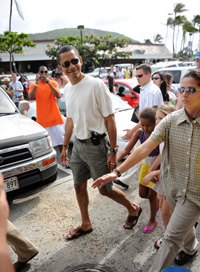WASHINGTON, DC – Since its Islamist revolution of 1979, Iran’s hardline leadership has relentlessly painted America as a racist, bloodthirsty power bent on oppressing Muslims worldwide. Nothing punctures this narrative more than the election of an African-American, Barack Obama, who supports dialogue with Iran and whose middle name – Hussein– is that of the central figure in Shi’a Islam. While the Bush administration’s policies often served to unite Iran’s disparate political landscape against a common threat, an Obama presidency could accentuate the country’s deep internal divisions.
 |
| US President-elect Barack Obama holds his daugher Sasha's hand while walking to get shaved ice during an afternoon outting December 26, 2008 in Hawai'i Kai, Hawaii. AFP |
Though intolerant conservatives are currently in firm control of Iran’s government, the moderates and reformists among the political elite – dormant but not dead – may be resuscitated by Obama’s victory. They were swept out of power by hardliners who used the country’s jittery sense of security – accentuated by the presence of tens of thousands of American troops in neighboring countries – as a pretext to rig elections, stifle dissent, and reverse political and social freedoms. But reformists are likely to mount a rigorous challenge to President Mahmoud Ahmadinejad as he seeks re-election in June 2009.
Similarly, for Iran’s young population – the least anti-American in the Middle East – there is now renewed hope for reconciliation with the United States, something that seemed impossible during the Bush years. While popular skepticism toward American policies lingers, there remains a widespread recognition among Iranians that their country will never emerge from isolation or fulfill its enormous potential as long as its relationship with the US remains adversarial. The Iranian public, sidelined and disillusioned in recent years, is set to reemerge on the political scene.
But while a majority of Iran’s population and a sizable chunk of its political elite recognize that the “death to America” culture created in 1979 is obsolete, small but powerful cliques – both within Iran and among the country’s Arab allies – have entrenched economic and political interests in preventing a rapprochement with the US.
Domestically, Iranian hardliners recognize that improved ties with the US could catalyze political and economic reforms that would undermine the quasi-monopolies they enjoy with the country in isolation.
Among Arab allies such as Hezbollah and Hamas, the prospect of US-Iranian diplomatic accommodation – in which the US changes its approach toward Iran, and Iran changes its approach toward Israel – could mean an end to their chief ideological patron and primary source of funding.
For this reason, when and if a serious dialogue commences, the spoilers will likely attempt to torpedo it by issuing belligerent rhetoric, targeting US soldiers and interests in Iraq or Afghanistan, or seeing to it that an arms shipment originating from Iran is “discovered” en route to south Lebanon or Gaza. They have had a remarkably successful track record over the years at sabotaging any chance of a diplomatic breakthrough.
The tenor of US-Iran relations will depend greatly on 69-year-old Iranian Supreme Leader Ayatollah Ali Khamenei. He is more powerful than ever, as the country's most important institutions – the Revolutionary Guards, Guardian Council, presidency and parliament – are currently led by individuals who were either directly appointed by him or are unfailingly loyal to him.
If history is any guide, a dramatic shift in Iran’s domestic and foreign policy practices is unlikely as long as Khamenei remains at the helm. His 20-year track record reveals a risk-averse leader who seeks neither confrontation nor accommodation. Khamenei is deeply mistrustful of US intentions, for he is convinced that America’s ultimate goal – regardless of who is US president – is not behavioral change but regime change in Iran.
An important task of the Obama administration will be to probe Khamenei’s true disposition. Despite public appearances, does he secretly aspire to a more amicable relationship with the US? Or does he believe that enmity toward the US is necessary to retain the ideals of the revolution and the legitimacy of the Islamic Republic? Could a more moderate approach by the Obama administration beget a more conciliatory response from Khamenei? The only way to test these hypotheses is via direct US-Iran dialogue.
Ultimately, our expectations of Obama’s ability to influence US-Iran relations should be realistic. The US can and should make clear to Iran that it is eager to put aside 30 years of mutual mistrust and hostility and establish a new tone and context for the relationship. It will require a sustained effort and enormous patience, but could be hugely beneficial to US strategic interests.
While Iran may not be ready to change its relationship with America, even an unsuccessful US attempt to reach out has merit. If and when it becomes evident that hardliners in Iran – not America – are the chief impediment to better relations, internal elite and popular opposition could build, and potentially large, unpredictable cleavages could be created within the Iranian political system.
* Karim Sadjadpour is an associate at the Carnegie Endowment for International Peace.
Copyright: Project Syndicate, 2008. Exclusive to The Sunday Times |

